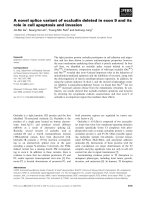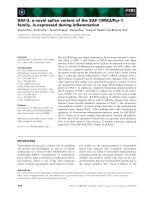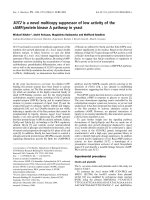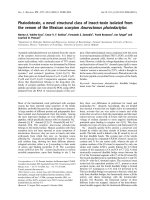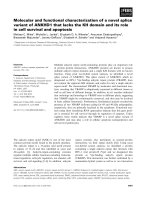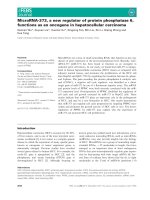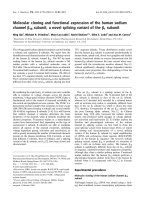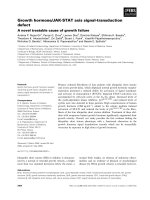A functional microRNA library screen reveals miR-410 as a novel anti-apoptotic regulator of cholangiocarcinoma
Bạn đang xem bản rút gọn của tài liệu. Xem và tải ngay bản đầy đủ của tài liệu tại đây (1.74 MB, 9 trang )
Palumbo et al. BMC Cancer (2016) 16:353
DOI 10.1186/s12885-016-2384-0
RESEARCH ARTICLE
Open Access
A functional microRNA library screen
reveals miR-410 as a novel anti-apoptotic
regulator of cholangiocarcinoma
Tiziana Palumbo1†, George A. Poultsides2†, Grigorios Kouraklis3, Theodore Liakakos4, Alexandra Drakaki5,
George Peros6, Maria Hatziapostolou7,1* and Dimitrios Iliopoulos1*
Abstract
Background: Cholangiocarcinoma is characterized by late diagnosis and a poor survival rate. MicroRNAs have been
involved in the pathogenesis of different cancer types, including cholangiocarcinoma. Our aim was to identify novel
microRNAs regulating cholangiocarcinoma cell growth in vitro and in vivo.
Methods: A functional microRNA library screen was performed in human cholangiocarcinoma cells to identify
microRNAs that regulate cholangiocarcinoma cell growth. Real-time PCR analysis evaluated miR-9 and XIAP mRNA
levels in cholangiocarcinoma cells and tumors.
Results: The screen identified 21 microRNAs that regulated >50 % cholangiocarcinoma cell growth. MiR-410 was
identified as the top suppressor of growth, while its overexpression significantly inhibited the invasion and colony
formation ability of cholangiocarcinoma cells. Bioinformatics analysis revealed that microRNA-410 exerts its effects
through the direct regulation of the X-linked inhibitor of apoptosis protein (XIAP). Furthermore, overexpression of
miR-410 significantly reduced cholangiocarcinoma tumor growth in a xenograft mouse model through induction
of apoptosis. In addition, we identified an inverse relationship between miR-410 and XIAP mRNA levels in human
cholangiocarcinomas.
Conclusions: Taken together, our study revealed a novel microRNA signaling pathway involved in
cholangiocarcinoma and suggests that manipulation of the miR-410/XIAP pathway could have a therapeutic
potential for cholangiocarcinoma.
Keywords: Cholangiocarcinoma, microRNA screen, miR-410, XIAP, apoptosis, microRNA therapy
Background
Cholangiocarcinoma (CCAs) represents a heterogeneous
group of epithelial cancers highly resistant to chemotherapy. They occur in about one to two people per
100,000 and represent approximately 7 % of all gastrointestinal cancer [1]. The most contemporary classification based on anatomical location includes intrahepatic,
perihilar, and distal CCA. Intrahepatic CCA arises from
* Correspondence: ;
edu
†
Equal contributors
7
Centre for Biological Sciences, University of Southampton, Southampton, UK
1
Center for Systems Biomedicine, Division of Digestive Diseases, David
Geffen School of Medicine, UCLA, 650 Charles E. Young Dr., CHS 44-133, Los
Angeles, CA 90095-7278, USA
Full list of author information is available at the end of the article
the intrahepatic bile ducts and is relatively uncommon,
representing 20 % of CCA case [2]. Perihilar cholangiocarcinoma represents about 50 % of the cases and is
localized at the hilum of the liver, between the second
order biliary radicals and the insertion of the cystic duct
into the common bile duct. Distal CCA arises from
the common bile duct and accounts for the remaining
30 % of cases. According to a recent classification,
hepatocellular-cholangiocellular carcinoma has emerged as
distinct histologic subtype of cholangiocarcinoma [3].
Currently, surgical resection, in addition to orthotopic liver
transplantation for perihilar tumors, are the only treatment
options associated with long-term survival, however only a
minority of patients are candidates for such therapies.
Combination chemotherapy with gemcitabine and cisplatin
© 2016 The Author(s). Open Access This article is distributed under the terms of the Creative Commons Attribution 4.0
International License ( which permits unrestricted use, distribution, and
reproduction in any medium, provided you give appropriate credit to the original author(s) and the source, provide a link to
the Creative Commons license, and indicate if changes were made. The Creative Commons Public Domain Dedication waiver
( applies to the data made available in this article, unless otherwise stated.
Palumbo et al. BMC Cancer (2016) 16:353
is associated with a median survival of 12 months in patients with advanced disease who are not candidates for
curative surgical resection. The highly desmoplastic nature
of cholangiocarcinoma, its extensive support by a rich
tumor microenvironment, and profound genetic heterogeneity, all contribute to its therapeutic resistance [4].
MicroRNAs are small non-coding RNAs that control
gene expression by inhibiting mRNA translation or by
promoting mRNA degradation, and have emerged as
critical components of essential signaling pathways, such
as proliferation, differentiation and apoptosis [5]. MicroRNAs have been involved in the pathogenesis of different types of cancer; however their role and function in
cholangiocarcinoma (CCA) pathogenesis has not been
widely explored. Recent studies have reported microRNAs (miR-26a, miR-141, miR-210, miR-31, miR-21 and
miR-421) having oncogenic function in CCAs by modulating cell proliferation signaling pathways [6] [7]. Furthermore, miR-21 was found to regulate programmed cell
death 4 (PDCD4) in CCA [8]. On the other hand, other
microRNAs have been found to be down-regulated in cholangiocarcinomas compared to non-malignant cholangiocytes. Mott et al. showed an inverse correlation between
miR-29b and the expression of the anti-apoptotic protein
myeloid cell leukemia-1 protein (Mcl-1) [9], a member of
the Bcl-2 protein family, which can promote cell survival
through suppression of cytochrome c release from mitochondria. Previous studies revealed that microRNA-410 is
deregulated in different types of cancer, including neuroblastoma, breast cancer and prostate cancer, acting as a
tumor suppressor gene [10–12], however the role of
miR-410 in cholangiocarcinoma remains to be examined.
Apoptosis, a form of programmed cell death, is known
to play an essential role in embryonic development and
maintenance of cellular and tissue homeostasis [13]. Evasion of apoptosis is one of the key hallmarks of malignant growth. Furthermore, loss of the normal control of
cell longevity is also thought to confer increased resistance to chemotherapeutic agents, many of which utilize
these pathways to induce cell death [14]. Decreased
apoptosis of tumor cells results from either a deficiency
of pro-apoptotic molecules or expression of inhibitors of
apoptotic pathways. The Bcl-2 protein family is a major
regulator of cell survival, able to promote or suppress
apoptosis [15]. Mcl-1 is essential for the development of
various solid tumor types, including CCA, and plays a
pivotal role in protecting CCA cells from apoptosis. BclxL has been found to block cell death induced by a variety
of chemotherapeutic agents, and its overexpression in
CCA cells has been reported previously in [16, 17].
Moreover, NF-kB transcription factor is known to
regulate the expression of anti-apoptotic genes and is
associated with resistance to apoptosis in cancer cells,
including CCA cells. NF-kB has been reported to control
Page 2 of 9
the expression of cell survival proteins such as Bcl-xL [18]
and X-linked inhibitor of apoptosis protein (XIAP) [19].
Therefore, understanding and modulating apoptotic pathways in cholangiocarcinoma cells may provide a potential
for therapeutic intervention.
Here, our aim was to identify novel microRNAs regulating the growth of cholangiocarcinoma cells in vitro and in
vivo. We have performed a functional microRNA library
(316 microRNA mimics) screen and found 21 microRNAs
that induced or suppressed significantly (>50 %) cholangiocarcinoma cell growth. Specifically, miR-410 was identified
as the top suppressor of cholangiocarcinoma TFK-1 cell
growth. Experimental analysis revealed that miR-410 regulates the colony formation ability and invasiveness of cholangiocarcinoma cells, through binding in the 3’UTR of the
X-linked inhibitor of apoptosis protein (XIAP) antiapoptotic factor. Furthermore, miR-410 and XIAP mRNA
expression levels were inversely correlated in human cholangiocarcinoma tissues. Also, overexpression of miR-410
reduced cholangiocarcinoma growth in vivo.
Methods
MicroRNA library screen
A microRNA library, consisting of 316 microRNA
mimics and 2 microRNA negative controls, (at a concentration of 100 nM) (Dharmacon Inc) was transfected in
TFK-1 cholangiocarcinoma cells plated in 96-well plates
(three replicates). TFK-1 cell growth was evaluated,
48 h post microRNA transfection, by using a cell
proliferation kit (cat. no. 302011, Agilent). MicroRNAs that affected >50 % TFK-1 cell growth were considered as positive hits. The microRNAs that suppressed
>50 % TFK-1 cell growth were evaluated in a secondary
screen by using the same experimental conditions in
6-well plates.
RNA isolation from patient samples
RNA was extracted from twenty two pairs of cholangiocarcinoma and normal adjacent tissues, collected at the
Department of Surgery at Stanford Medical Center, by
using the Trizol method (Invitrogen, Carlsbad, CA),
according to manufacturer’s instructions. All the experiments were performed in accordance with relevant
guidelines and regulations. An informed written consent
has been obtained from all subjects included in this study.
The study has been approved by the Institutional Review
Board and the Ethics Committee of the Stanford University
Medical School.
Real-time polymerase chain reaction analysis
MicroRNA expression levels were assessed by real-time
polymerase chain reaction (PCR) on a CFX-384 detection
system (Bio-Rad, Hercules, CA) using the Exiqon PCR
primer sets according to manufacturer’s instructions
Palumbo et al. BMC Cancer (2016) 16:353
(Exiqon Inc., Woburn, MA). All primers for the microRNAs and the reference genes (U6 small nuclear RNA
and 5S ribosomal RNA) were purchased from Exiqon Inc.
Real-time PCR (Bio-Rad) for XIAP, GAPDH and
beta-actin mRNAs was performed in the same RNA samples extracted from biopsies.
Page 3 of 9
cells on the top sides of the membrane were removed
while invading cells were fixed and stained with 4`-6`
diamidino-2 phenylindole, DAPI, 16 h post seeding. In
the assay,10 fields for insert were scored and SD was
measured.
Xenograft experiment
Cell culture
The extra hepatic bile duct carcinoma cell lines (TFK-1
and EGI-1) were purchased from DSMZ (German Collection of Microorganisms and Cell Cultures, Braunschweig,
Germany) and were cultured according to manufacturer’s
instructions.
XIAP 3′UTR luciferase assay
TFK-1 cells were transfected using Fugene6 reagent
(Roche) with Renilla reporter constructs (pEZX-MT01,
GeneCopoeia) carrying the 3′UTR of XIAP or XIAP
3`UTR mutated. Mutations were introduced into the
miRNA-binding sites by using the Quickchange Mutagenesis Kit (Stratagene, La Jolla, CA, USA). Thirty six
hours post transfection, luciferase assays were performed
using the Dual-Luciferase Reporter Assay (Promega,
Madison, WI).
Caspase 3/7 apoptosis assay
For detection of caspase 3/7 activity, cells were transfected with 100nM of miR-410 mirVana microRNA
mimic or the negative control #1 (miR-NC) and were
analyzed using the Caspase-Glo 3/7 Assay kit, 48 h later
(Promega) according to the manufacturer’s instructions.
Furthermore, caspase 3/7 activity was evaluated in TFK1 xenograft tumors (day 35) treated with miR-410 or
miR-NC and untreated tumors.
Western blot analysis
Immunoblotting was performed following standard
procedures. XIAP (#2042), Cleaved Caspase-3 (#9664),
Caspase-3 (#9662), PARP (#9542) and Cleaved PARP
(#9544) antibodies were purchased from Cell Signaling
Technology.
Colony formation assay
TFK-1 cells were transfected with miR-410 mimic and
miR-410 inhibitor for 48 h and colony formation was
determined as previously described [20].
Invasion assay
We performed invasion assays in TFK-1 cholangiocarcinoma cell line, which was transfected with miR-410 for
48 h, by using standardized condition with BD Biocoat
Matrigel Invasion Chamber, as previously described [20].
Assay was conducted according to manufacturer’s protocol, by using 10 % FBS as chemoattractant. Non invading
5x106 TFK-1 cells were injected subcutaneously in the
right flank of athymic nude mice. Tumor growth was
monitored every five days and when the tumors reached
a size of ~100 mm3 (day 15) mice were randomly
distributed in 3 groups (3 mice/group). The first group
of mice was the control group (untreated), the second
was i.p. treated with miR-NC (20 mg/kg) and the third
was i.p. treated with miR-410 (20 mg/kg). The miR-NC
and miR-410 treatments were repeated every 5 days
for 4 cycles, starting on day 15.
Immunohistochemistry
Tissue immunostaining for XIAP, in FFPE sections of
normal biliary ducts and CCAs was performed as previously described [20]. XIAP (#2945, Lifespan Biosciences,
Inc.) antibody was diluted in TBS-T-goat serum and
incubated overnight at 4 °C. Sections were stained with
DAB Peroxidase Substrate Kit and counterstained with
hematoxylin QS. Images were captured with a Nikon
90i Upright Microscope equipped with a Nikon
Digital camera.
In situ hybridization
Double-DIG labeled Mircury LNA probe for the detection of hsa-miR-410 (38007–15, Exiqon), by in situ
hybridization, was used. Section of control and cholangiocarcinoma were deparaffinized with xylene (three
times for 5 min), followed by treatment with serial
dilutions of ethanol (three times in 100 %, twice in 96 %
and three times in 70 %) and by two changes of DEPCPBS. Tissues were then digested with proteinase K for
30 min at 37 °C, rinsed three times with DEPC-PBS.
Section were dehydrated twice with 70 %, 96 % and 100 %
ethanol, air-dried and hybridized for 1 h with the
has-miR −410 (40nM) diluted in microRNA IHS buffer,at
60 °C. Following hybridization, section were rinsed twice
with 5XSSC,twice with 1XSSC and three times with
0.2XSSC,5 min each,at 60 °C and PBS . The slides were
incubated with blocking solution (Roche) for 15 min and
then with anti –DIG antibody (1:800) in 2 % sheep serum
(Jackson Immunoresearch) blocking solution for 1 h at
RT. Following three washes wit PBS-T (PBS 0.1 %,Tween
20),slides were incubated with the AP substrate buffer in
10 ml 0.2 mM Levamisole (Fuka) for 2 h at 30 °C in the
dark. The reaction was stopped with two washes of AP
stop solution (50 mM Tris–HCl,150 mM NaCl,10 mM
KCl) and two washes of water. Tissue were counter
Palumbo et al. BMC Cancer (2016) 16:353
stained with Nuclear Fast Red for 1 min and rinsed with
water and images were captured with a Nikon 90i Upright
microscope equipped with a Nikon Digital Camera.
Statistical analysis
Data were analyzed by unpaired Student t test and Pearson correlation. Results are presented as means ± SD or
SEM, as indicated, or as boxes and whiskers (minimum
to maximum). A P value < .05 was considered statistically significant.
Results
MicroRNA library screen identifies miR-410 as a novel
regulator of cholangiocarcinoma
To identify microRNAs that have functional importance
and therapeutic potential in cholangiocarcinoma, we
have performed a high throughput microRNA library
screen in TFK-1 cholangiocarcinoma cells. Specifically, a
library of 318 microRNAs, including 2 microRNA negative controls (miR-NCs), was transfected in TFK-1 cells
and 48 h post transfection TFK-1 cell growth was evaluated (Fig. 1a). Positive hits were defined as microRNAs
that affected positively or negatively TFK-1 cell growth
by more than 50 % (Fig. 1b). This screen identified 10
microRNAs (miR-21, miR-19a, miR-17-5p, miR-26a,
miR-26b, miR-107, miR-106b, miR-27a, miR-103, miR25) that increased more than 50 % TFK-1 growth and 11
microRNAs (miR-513, miR-200b, miR-198, miR-200c,
miR-520e, miR-429, miR-124a, miR-101, miR-29b, miR494, miR-410) that decreased >50 % cell growth (Fig. 1c).
Interestingly, our screen showed miR-21 as the top
inducer, while miR-410 was found as the top suppressor
of TFK-1 cell growth. Since we were interested in identifying microRNAs that have the ability to suppress
cholangiocarcinoma cell growth, we focused our interest
on the microRNAs that showed the highest suppressive
effects. To validate the primary screen analysis, we have
performed a secondary screen and validated that miR410 is the top suppressor of TFK-1 cell growth (Fig. 1d).
Taken together, these data suggest a potential role for
miR-410 as a central regulator of cholangiocarcinoma
cell proliferation [6].
MiR-410 affects colony formation, apoptosis and
invasiveness of cholangiocarcinoma cells
We further assessed the tumor suppressive properties of
miR-410 in cholangiocarcinoma, by transfecting miR410 in TFK-1 cells and performed different functional
assays. First, we found that miR-410 overexpression
suppressed by ~70 % TFK-1 cell growth, 96 h posttransfection, in comparison to TFK-1 cells transfected
with a microRNA negative control (miR-NC) (Fig. 2a).
In addition, miR-410 overexpression resulted in >80 %
inhibition on the colony formation ability of TFK-1 cells
Page 4 of 9
(Fig. 2b). Next, we performed an invasion assay and identified that miR-410 overexpression suppressed by 6.6-fold
the invasiveness of TFK-1 cells (Fig. 2c). Also, we found
that miR-410 up-regulation increased the apoptotic potential of TFK-1 cells by increasing the caspase 3/7 activity,
assessed by ELISA assay (Fig. 2d). To further examine the
role of miR-410 in inducing apoptosis in TFK-1 cells, we
performed western blot analysis in TFK-1 cells for cleaved
caspase-3 and cleaved PARP, both markers of the intrinsic
apoptotic pathway. Our analysis showed that miR-410 induced the cleavage of both molecules (Fig. 2e), suggesting
that miR-410 regulates cholangiocarcinoma cell growth,
through regulation of apoptotic signaling pathways. Taken
together, these data propose that miR-410 controls essential properties of cholangiocarcinoma cells, including their
ability to form colonies in soft agar and their invasiveness.
MiR-410 administration suppresses TFK-1 tumor growth
in vivo
To further validate our in vitro findings, we examined
the in vivo significance of miR-410 administration in
cholangiocarcinoma oncogenesis. Specifically, TFK-1
cells were injected subcutaneously in nude mice and
when tumors reached the size of 100 mm3, the mice
were randomly distributed in three groups. The first
group was the control group (untreated), the second
group of mice was i.p. treated with miR-NC and the 3rd
group was i.p. treated with miR-410. We found that
miR-410 administration, significantly suppressed TFK-1
xenograft tumor growth (Fig. 2f ) through induction of
apoptosis (Additional file 1: Figure S1). These data show
that miR-410 suppresses TFK-1 tumor growth in vivo,
suggesting its therapeutic potential for cholangiocarcinoma patients.
MiR-410 induces apoptosis of cholangiocarcinoma cells
through direct regulation of XIAP anti-apoptotic factor
According to our in vitro and in vivo findings above,
miR-410 regulates the growth of cholangiocarcinoma
cells and its overexpression induces apoptosis as shown
by the activation of caspase-3 and PARP pathways. Thus,
we were interested in identifying potentially a miR-410
direct downstream gene target related to cell growth and
apoptotic pathways. We performed a bioinformatics
analysis by using two prediction algorithms (Targetscan
and Diana), to identify putative mRNA 3`UTR targets
for the mature miR-410. Among the top genes predicted
by both databases, XIAP was identified as a potential
target of miR-410. We found that miR-410 has a seed
region that matches the 3′-untranslated region (UTR) of
human XIAP (nucleotides 2264–2271) (Fig. 3a). XIAP is a
critical barrier to apoptotic cell death because it can directly inhibit the activation of caspases and therefore block
normal apoptosis activation [21, 22]. Thus, we focused
Palumbo et al. BMC Cancer (2016) 16:353
Page 5 of 9
Fig. 1 Identification of microRNAs regulating TFK-1 cell growth, by performing a microRNA library screen. a Schematic representation of the
screen. b Data points correspond to each microRNA. c The effects of the top microRNAs on increasing (red color) or reducing (green color) cholangiocarcinoma
cell growth. d A secondary screen testing the effects of the top five hits identified from the primary microRNA library screen in TFK-1 cells
our interest on studying experimentally the potential
direct interaction between miR-410 and XIAP. To verify
the direct interaction between miR-410 and XIAP, we performed a 3’UTR luciferase assay. Specifically, miR-410
overexpression decreased 50 % XIAP 3’UTR luciferase activity in TFK-1 cells (Fig. 3b). On the other hand, mutation
of the miR-410 binding site within the XIAP 3′-UTR
abolished the ability of miR-410 to regulate the 3’UTR
luciferase activity (Fig. 3b). Furthermore, we examined
the effects of miR-410 on regulating XIAP expression
levels. Transfection of miR-410 in TFK-1 cholangiocarcinoma cells resulted in a significant reduction of XIAP
mRNA levels in comparison to cells transfected with miRNC (Fig. 3c). In addition, we found that miR-410 overexpression decreased XIAP protein levels in the same cell
line (Fig. 3d). To further validate our findings of miR-410
regulation of XIAP expression, we have used a second
(EGI-1) cholangiocarcinoma cell line. Consistent with our
previous findings, miR-410 overexpression decreased significantly XIAP mRNA expression levels (Fig. 3e). Overall,
Palumbo et al. BMC Cancer (2016) 16:353
Page 6 of 9
Fig. 2 MiR-410 plays a pivotal role in cholangiocarcinoma growth and invasiveness. a Overexpression of miR-410, suppresses effectively the cell
growth of TFK-1 cell line. b Number of colonies (>50 μm) of TFK-1 cells treated with miR-NC or miR-410 for 48 h. c Invasion assay of TFK-1 cells
treated with miR-NC or miR-410 for 24 h. d Apoptosis was evaluated by caspase 3/7, 48 h after transfection. TFK-1 cells were transfected with
miR-NC, miR-410 or as-miR-410. e Evaluation of caspase-3 and PARP pathways after miR-410 overexpression (48 h post transfection) by western
blot analysis. Representative pictures of Western blot analysis for cleaved caspase-3 and PARP after miR-NC and miR-410 enforced expression in
TFK-1 cells. Total caspase-3 and total PARP were used as the loading control. f Tumor growth of TFK-1 cells in nude mice after i.p. treatment with
miR-NC or miR-410. Arrows indicate the administration of miRNAs (days 15, 20, 25 & 30)
these data suggest that miR-410 regulates directly XIAP
expression levels through binding in its 3’UTR.
Human relevance of the miR-410/XIAP signaling pathway
in cholangiocarcinoma
Our findings have identified that miR-410 is an important
regulator of cholangiocarcinoma growth in vitro and in
vivo. Next, we investigated whether the miR-410/XIAP signaling pathway is deregulated in human cholangiocarcinoma tissues. MiR-410 and XIAP mRNA levels were
evaluated by real-time PCR analysis in 22 pairs of cholangiocarcinoma and adjacent normal tissues. MiR-410 expression levels were found to be reduced, while XIAP mRNA
levels were increased in cancer when compared to normal
Palumbo et al. BMC Cancer (2016) 16:353
Page 7 of 9
Fig. 3 MiR-410 targets XIAP mRNA by direct binding to its 3′UTR. a Bioinformatics analysis identified complementarity of XIAP mRNA and the
“seed sequence” of miR-410. b Luciferase activity of a reporter vector harboring the 3′UTR of XIAP (WT-wild type and MUT- the deletion mutant
in the miR-410 recognition element) and c Real-time RT-PCR analysis for XIAP mRNA levels in TFK-1 cells transfected with miR-NC or miR-410 for
36 h. d Representative picture of Western blot analysis for XIAP in TFK-1 cells transfected with miR-NC or miR-410. e Real-time RT-PCR analysis for
XIAP mRNA levels in EGI-1 cells transfected with miR-NC or miR-410 for 36 h
tissues (Fig. 4a, b). Furthermore, immunohistochemical
analysis for XIAP and in situ hybridization for miR-410, in
sections from additional biopsies, revealed increased staining of XIAP, in the nuclei of epithelial cells, and decreased
staining of miR-410 in the cholangiocarcinoma tumors
samples (Fig. 4c), indicating the human relevance of this
pathway in cholangiocarcinoma oncogenesis.
Discussion
To our knowledge, this is the first study showing a functional role for miR-410 in cholangiocarcinoma through
regulation of XIAP pathway. We have identified miR410 as an important suppressor of cholangiocarcinoma
growth both in vitro and in vivo We demonstrated that
miR-410 negatively modulates XIAP expression regulating this way the intrinsic apoptotic signaling pathway.
We also found that miR-410 treatment is able to suppress
CCA tumor growth in xenografts, suggesting its therapeutic potential for CCA patients. Most importantly, we
provide evidence that the miR-410/XIAP signaling pathway is deregulated in human cholangiocarcinoma tissues.
Previous studies have investigated the role of miR-410 in
different types of cancer. Chien et al. [23] found that miR410 negatively regulates pRb/E2Fpathway by directly
targeting CDK1 oncogene in breast cancer. Furthermore,
Gattoliat et al. [11] showed that miR-410 expression is significantly associated with disease free survival of neuroblastoma. More recently, miR-410 was found to have decreased
expression in a panel of prostate cancer cell lines [12]. The
current study is the first one that identifies miR-410 as a
major regulator of cholangiocarcinoma growth showing
both functional importance and therapeutic potential.
Elevated XIAP expression has been reported in a variety
of human cancers and is associated with adverse tumor
histology and decreased patient survival. Recent reports
revealed that XIAP play an important role in different signaling pathways including NF-kB, MAP kinase and the
ubiquitin proteasome pathways, and modulates a variety
of cellular processes, including inflammation, cell division
and differentiation, cell migration and metal metabolism
[24–26]. Furthermore, research efforts have been focused
on the development of drugs targeting XIAP as a new approach to counteract cancer and overcome drug resistance
[27, 28]. Given that increased levels of XIAP have been
associated with chemo-resistance [29–31], and based
on our data, it is possible that the miR-410/XIAP
pathway may contribute to the refractoriness of human
cholangiocarcinoma to conventional chemotherapy or
Palumbo et al. BMC Cancer (2016) 16:353
Page 8 of 9
Fig. 4 Inverse correlation between miR-410 and XIAP levels in cholangiocarcinoma tissues and controls. a-b Expression levels of miR-410 and XIAP
in normal (n = 12) and cholangiocarcinoma (cancer, n = 22) patient tissues. Results are presented as boxes with whiskers (minimum to maximum),
relative to normal. c Correlation of miR-410 to XIAP mRNA levels. R corresponds to correlation coefficient. d In situ hybridization for miR-410
(black) and immunostaining for XIAP (brown stain) in normal and CCA tissues
radiation therapy. Taken together, our study revealed a
novel microRNA signaling pathway involved in cholangiocarcinoma oncogenesis.
In the last 5 years, there is extensive effort to develop
microRNA mimics and microRNA inhibitors that could be
potentially used therapeutically in cancer patients. In
addition, chemical modifications in the microRNAs have
been created in order to enhance their potency and
bio-availability and decrease their degradation by RNAses
[20]. Previous studies have shown that microRNAs could
be delivered by intratumoral, intraperitoneal or intravenous injections with minimal toxicities [32]. In our study,
miR-410 expression is lost in cholangiocarcinomas, thus
miR-410 restoration of expression through a microRNA
mimic could represent a potential therapeutic target for
cholangiocarcinoma patients. A recent study showed that
restoration of miR-26a expression suppressed tumor
growth in a liver cancer mouse model [33]. Overall,
microRNA mimics have a great potential to be used as
therapeutic agents in cancer patients, however additional
studies are needed in order to optimize their specificity
and effectiveness, minimizing their off-target effects.
Conclusions
MicroRNAs are master regulators of gene expression affecting multiple cancer signaling pathways involved in
different types of cancer, including cholangiocarcinomas.
Our findings suggest that the miR-410 is an important
regulator of cholangiocarcinoma cell growth in vitro and
in vivo, through regulation of the anti-apoptotic factor
XIAP. Furthermore, miR-410 administration could be a
therapeutic strategy for cholangiocarcinoma patients
that should be further examined in greater detail in
cholangiocarcinoma animal models.
Additional file
Additional file 1: Figure S1. Increased apoptotic activity in xenograft
tumors (day 35) treated with miR-410 relative to miR-NC, assessed by
caspase 3/7 ELISA assay (Promega). (PPTX 50.3 kb)
Abbreviations
3’UTR, 3’ untranslated region; CCA, Cholangiocarcinoma; MCL1, myeloid cell
leukemia-1 protein; miR-NC, microRNA-negative control; PDCD4, programmed
cell death 4; XIAP, X-linked inhibitor of apoptosis protein
Acknowledgements
None.
Funding
This study was supported by start-up funds provided from the Division of
Digestive Diseases at David Geffen School of Medicine at UCLA (DI).
Availability of data and materials
The datasets supporting the conclusions of this article are included within
the article and its additional files.
Palumbo et al. BMC Cancer (2016) 16:353
Authors’ contributions
MH and DI wrote the manuscript text, DI, GAP, TL, GK and GP contributed to
the design of the study, GAP provided all the tissue samples, TP, AD and MH
performed the experiments, MH and TP prepared the figures and TL, GK and
GP performed critical revision the manuscript. All authors have reviewed the
submitted version of the manuscript. All authors read and approved the final
manuscript.
Authors’ information
None.
Competing interests
The authors declare that they have no competing interests.
Consent for publication
Not Applicable.
Ethics approval and consent to participate
RNA was extracted from twenty two pairs of cholangiocarcinoma and
normal adjacent tissues, collected at the Department of Surgery at Stanford
Medical Center. An informed written consent has been obtained from all
subjects included in this study. The study has been approved by the
Institutional Review Board and the Ethics Committee of the Stanford
University Medical School. All animal studies were approved by the UCLA
David Geffen School of Medicine institutional animal care and use
committee.
Author details
1
Center for Systems Biomedicine, Division of Digestive Diseases, David
Geffen School of Medicine, UCLA, 650 Charles E. Young Dr., CHS 44-133, Los
Angeles, CA 90095-7278, USA. 2Department of Surgery, Stanford University
School of Medicine, Stanford, CA, USA. 32nd Department of Propedeutic
Surgery, University of Athens School of Medicine, Athens, Greece. 43rd
Department of Surgery, University of Athens School of Medicine, Attikon
University Hospital, Athens, Greece. 5Division of Hematology/Oncology,
David Geffen School of Medicine, UCLA, Los Angeles, CA, USA. 64th
Department of Surgery, University of Athens School of Medicine, Attikon
University Hospital, Athens, Greece. 7Centre for Biological Sciences, University
of Southampton, Southampton, UK.
Received: 25 November 2015 Accepted: 25 May 2016
References
1. Cardinale V et al. Cholangiocarcinoma: increasing burden of classifications.
Hepatobil Surg Nutr. 2013;2:272–80.
2. Razumilava N, Gores GJ. Combination of gemcitabine and cisplatin for
biliary tract cancer: a platform to build on. J Hepatol. 2011;54:577–8.
3. Komuta M et al. Histological diversity in cholangiocellular carcinoma reflects
the different cholangiocyte phenotypes cancer. Hepatology. 2012;55:1876–88.
4. Razumilava N, Gores GJ. Cholangiocarcinoma. Lancet. 2014;383:2168–79.
5. Hatziapostolou M, Polytarchou C, Iliopoulos D. miRNAs link metabolic
reprogramming to oncogenesis. Trends Endocrinol Metab. 2013;24:361–73.
6. Haga H, Yan I, Takahashi Wood J, Patel T. Emerging insights into the role of
microRNAs in the pathogenesis of cholangiocarcinoma. Gene Expression.
2014;16:93–9.
7. Meng F et al. Involvement of human micro-RNA in growth and response to
chemotherapy in human cholangiocarcinoma cell lines. Gastroenterology.
2006;130:2113–29.
8. Selaru FM et al. MicroRNA-21 is overexpressed in human cholangiocarcinoma
and regulates programmed cell death 4 and tissue inhibitor of metalloproteinase
3. Hepatology. 2009;49:1595–601.
9. Mott JL, Kobayashi S, Bronk SF, Gores GJ. MiR-29 regulates Mcl-1 protein
expression and apoptosis. Oncogene. 2007;26:6133–40.
10. Chen L et al. MiR-410 regulates MET to influence the proliferation and
invasion of glioma. Int J Biochem Cell Biol. 2012;44:1711–7.
11. Gattolliat CH et al. Expression of miR-487b and miR-410 encoded by
14q32.31 locus is a prognostic marker in neuroblastoma. Br J Cancer.
2011;105:1352–61.
Page 9 of 9
12. Theodore SC et al. MicroRNA profiling of novel African American and
Caucasian prostate cancer cell lines reveals a reciprocal regulatory relationship
of miR-152 and DNA methyltransferase 1. Oncotarget. 2014;5:3512–25.
13. Thompson CB. Apoptosis in the pathogenesis and treatment of disease.
Science. 1995;267:1456–62.
14. Briggs CD et al. Prognostic molecular markers in cholangiocarcinoma: a
systemic review. Eur J Cancer. 2009;45:33–47.
15. Kobayashi S, Werneburg NW, Bronk SF, Kauffman SH, Gores GJ. Interleukine-6
contributes to Mcl-1 up-regulation and TRAIL resistance via an Akt-signaling
pathway in cholangiocarcinoma cells. Gastroenterology. 2005;128:2054–65.
16. Aggarwal BB, Vijayalekshmi RV, Sung B. Targeting inflammatory pathways
for prevention and therapy of cancer: short-term friend, long-Term foe. Clin
Cancer Res. 2009;15:425–30.
17. Seubwai W et al. Cepharanthine exerts antitumor activity on
cholangiocarcinoma by inhibiting NF-Kb. Cancer Sci. 2010;101:1590–5.
18. Zong WX, Edelstein LC, Chen C, Bash J, Gelinas C. The prosurvival Bcl-2
Homolog Bfl-1/A1 is a direct transcriptional target of NF-kB that blocks
TNF-α induced apoptosis. Genes Dev. 1999;13:382–7.
19. Stehlik C et al. Nuclear factor NF-kB-regulated X-chromosome–linked iap gene
expression protects endothelial cells from tumor necrosis factor α-induced
apoptosis. J Exp Med. 1998;188:211–6.
20. Hatziapostolou M et al. An HNFα-miRNA inflammatory feedback circuit
regulates hepatocellular oncogenesis. Cell. 2011;147:1233–47.
21. Riedl SJ et al. Structural basis for the inhibition of caspase-3 by XIAP. Cell.
2001;104:791–800.
22. Shiozaki EN et al. Mechanism of XIAP-Mediated inhibition of caspase-9. Mol
Cell. 2003;11:519–27.
23. Chien WW et al. Cyclin-dependent kinase1 expression is inhibited by
p16INK4a at the post–transcriptional level through the microRNA pathway.
Oncogene. 2011;30:1880–91.
24. Gyrd-Hansen M, Meier P. IAPs: from caspase inhibitors to modulators of NF-kB,
inflammation and cancer. Nat Rev Cancer. 2010;10:561–74.
25. Lu M et al. XIAP induces NF-kB activation via the BIR1/TAB1 interaction and
BIR1 dimerization. Mol Cell. 2007;26:689–702.
26. Wu Z-H et al. ATM-and NEMO-dependent ELSK ubiquitination coordinates
TAK1-mediated IKK activation in response to genotoxic Stress. Mol Cell.
2011;40:75–86.
27. Bilim V, Kasahara T, Hara N, Takahashi K, Tomita Y. Role of XIAP in the
malignant phenotype of transitional cell cancer (TCC) and therapeutic
activity of XIAP antisense oligonucleotides against multidrug-resistant TCC
in vitro. Int J Cancer. 2003;103:29–37.
28. La Casse EC et al. IAP-targeted therapies for cancer. Oncogene. 2008;27:
6252–75.
29. Hu Y et al. Antisense oligonucleotides targeting XIAP induce apoptosis and
enhance chemotherapeutic activity against human lung cancer cells in vitro
and in vivo. Clinical Cancer Res. 2003;9:2826–36.
30. Mansouri A, Zhang Q, Ridgway LD, Tian L, Claret F-X. Cisplatin resistance in
an ovarian carcinoma is associated with a defect in programmed cell death
control through XIAP regulation. Oncology Res. 2003;13:399–404.
31. Sasaki H, Sheng Y, Kotsuji F, Tsang BK. Down-regulation of X-linked Inhibitor
of Apoptosis Protein induces apoptosis in chemoresistant human ovarian
cancer cells. Cancer Res. 2000;60:5659–66.
32. Stenvang J, Silahtaroglu AN, Lindow M, Elmen J, Kauppinen S. The utility of
LNA in microRNA-based cancer diagnostics and therapeutics. Semin Cancer
Biol. 2008;18:89–102.
33. Kota J et al. Therapeutic microRNA delivery suppresses tumorigenesis in a
murine liver cancer model. Cell. 2009;137:1005–17.
